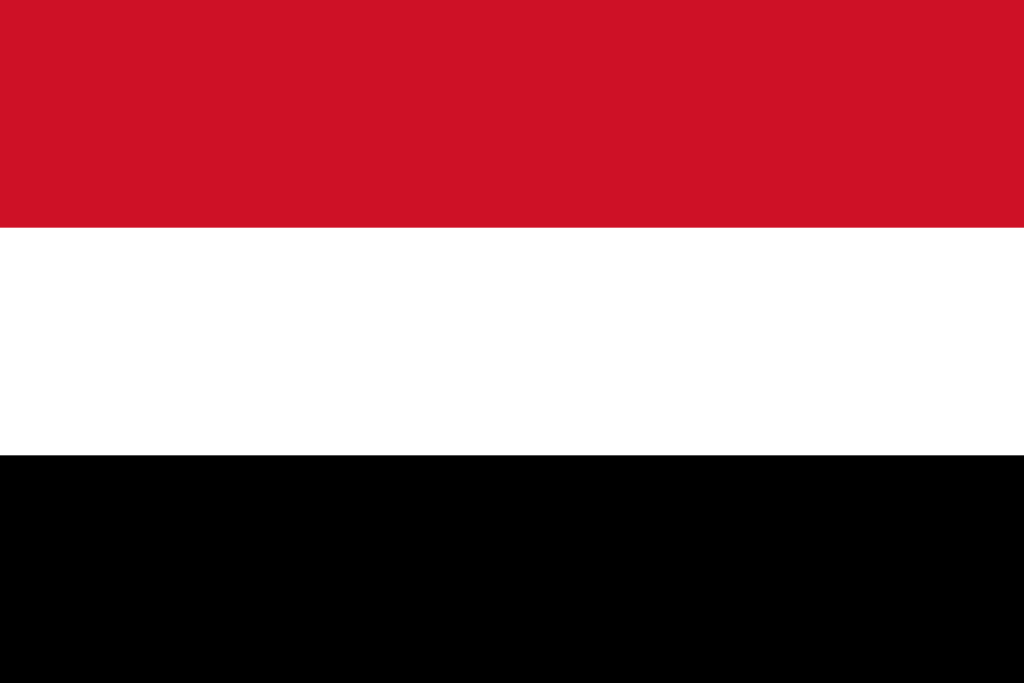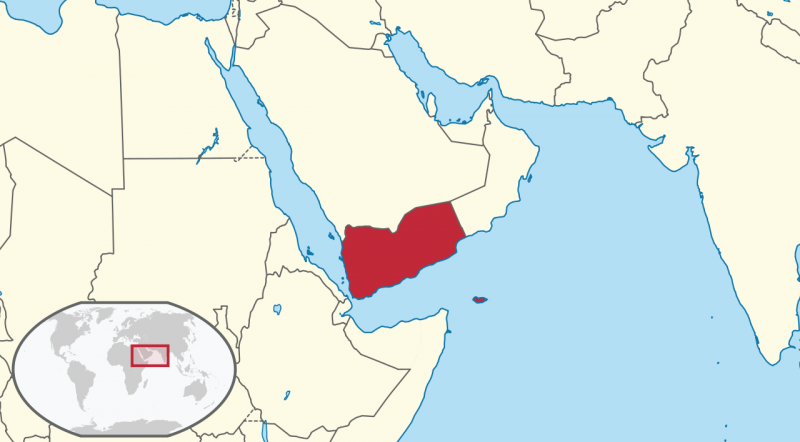
Geography

Source: This image is the intellectual property of TUBS. Redistribution under licence CC BY-SA 3.0
Area: 527,968 km2 (0% water)
Coastline: 1,906 km
Terrain: narrow coastal plain backed by flat-topped hills and rugged mountains; dissected upland desert plains in center slope into the desert interior of the Arabian Peninsula
Highest point: Jabal an Nabi Shuayb 3,760 m (west Yemen; close to the capital Sanaa)
Climate: mostly desert; hot and humid along west coast; temperate in western mountains affected by seasonal monsoon; extraordinarily hot, dry, harsh desert in east
Geographical population distribution: Over 90% of the population is concentrated in western half of Yemen
Natural resources: petroleum, fish, rock salt, marble; small deposits of coal, gold, lead, nickel, and copper; fertile soil in west
Demographics
Population: 29,825,970 (2020)Annual population growth: 2.3% (2020)
Population estimate in 2025: 33,140,000
Population distribution by age group (2020)0-14 – 39%
15-64 – 58%
65+ – 3%
Fertility rate (births per woman): 3.7 (2019)
Birth rate (births per 1000 people): 30 (2019)
Death rate (deaths per 1000 people): 6 (2019)
Median age: 19.1 years (2015)
Life expectancy (at birth): 66 years (2019)Males – 64 years
Females – 68 years
Net migration: -150,000 people (2017)
Language: Arabic is the official language
Religious groups: Shia Muslim 59.0%, Sunni Muslims 39.3%, Other religions 0.9%, Other Muslims 0.7%, Non-religious/atheists 0.1% (2015)
Ethnic groups: Arabs 93.4%, Somali 2.5%, Other 4.1% (2013)
Economy
GDP: $21.61 bil (2018)
GDP per capita: $758.1 (2018)
GDP annual growth rate: 0.8% (2018)
Public debt (% GDP): 63.2% (2019)
Inflation (CPI): 8.1% (2018)
Unemployment: 13.4% (2020) Imports: $4.7 bil (2019)5 largest import partners (% total imports - 2019): United Arab Emirates 24.04%, China 10.38%, Saudi Arabia 6.46%, Unspecified 6.45%, Oman 5.47%
Exports: $0.24 bil (2019)5 largest export partners (% total exports - 2019): Egypt 49.58%, Turkey 28.02%, Oman 10.53%, Sudan 9.34%,Eritrea 0.88%
Global Competitiveness Report (World Economic Forum)35.5/100 (2019 – position 140/141)
Index of Economic Freedom (Heritage Foundation)-
Income Inequality Index (Gini – World Bank)36.7% (2014)
Prosperity Index (Legatum Institute)31.14/100 (2021 – position 165/167)
Military Power
Republic of Yemen Government:300,000 military, paramilitary, and militia forces
UAE- and Saudi-backed forces: 150-200,000 trained fighters
Huthis: 200,000 fighters (2021)
Defence expenditure (% GDP): 4.0% (2014)
Politics and Government
Form of government: Semi-presidential republic (currently in transition)
President: Abdrabbuh Mansur Hadi (2012)Prime Minister: Maeen Abdulmalik Saeed (2018)
Executive branch: The President of Yemen is head of state while the Prime Minister serves as the head of government and is appointed by the President. According to the constitution, the legislature nominates at least two presidential candidates and the President is elected in direct popular elections. The President may serve up to two 7-year terms. Article 29 of the Constitution stipulates that the Council of Ministers is the highest executive and administrative authority of Yemen. The Prime Minister chooses the members of the Council of Ministers in consultation with the President. The Council of Ministers is responsible for the execution of overall state policies and, among others, prepares drafts of Laws and resolutions to be presented to the legislature or the President. The President also appoints a Vice President to assist him in his duties and to replace him temporarily in case the presidential seat becomes vacant.
Legislative branch: Yemen has a bicameral parliament. The Consultative Council is the upper house of parliament composed of 111 members appointed by the President (no term duration specified in the Constitution). The Consultative Council’s powers are mainly advisory. The House of Representatives is the lower house and consists of 301 members who are elected in direct popular elections for a 6-year term. However, elections have not taken place since 2003. The House of Representatives has the power to enact laws, create national policy, draft the budget and development plans and approve treaties. In addition, the House of Representatives may initiate a vote of no-confidence against the Prime Minister, any Minister or the whole government by a majority vote.
Judicial branch: The Supreme Judicial Council is appointed by the President, it regulates the country’s court system and it has the ability to control appointments, promotions and removals of judges. The court system is divided into lower courts and the Supreme Court which has the power of constitutional review, to decide conflicts between judicial bodies, to hear electoral challenges, and to act as a court of civil and criminal appeals concerning personal, disciplinary and administrative questions. The Supreme Court may also hear cases against the President, Vice President and members of the Council of Ministers.
Parliamentary parties (seats): General People’s Congress (238), Yemeni Congregation for Reform (Islah - 46), Yemeni Socialist Party (8), Nasserite Unionist Popular Organization (3), Arab Baath Socialist Party (2), Independents (4)
Last elections: Presidential elections 2012 – Abd Rabbuh Mansur Hadi was the only candidate. Turnout stood at 64.78% out of 10,243,364 voters.Next elections: Unknown
Rule of Law - Human Rights
Corruption Perceptions Index (Transparency International)15/100 (2020 - position 176/180)
Rule of Law Index (World Justice Project)
-
Global Terrorism Index (Institute for Economics & Peace)
7.259/10 (2019 – position 8/163)
Fragile States Index (Fund For Peace)
111.7/120 (2021 – position 1/178)
Democracy Index (Economist Intelligence Unit)
1.95/10 (2020 – position 157/167)
Press Freedom Index (Reporters Without Borders)
62.35/100 (2021 – position 169/180)
Freedom in the World Index (Freedom House)
11/100 (2021)




